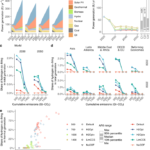2024-03-05 シンガポール国立大学(NUS)
 NUS researchers successfully integrated a new anion, cyanate, into a perovskite structure, which was a key breakthrough in fabricating new triple-junction perovskite/Si tandem solar cells.
NUS researchers successfully integrated a new anion, cyanate, into a perovskite structure, which was a key breakthrough in fabricating new triple-junction perovskite/Si tandem solar cells.
<関連情報>
- https://news.nus.edu.sg/new-tandem-solar-cells-with-world-record-efficiency/
- https://www.nature.com/articles/s41586-024-07226-1
超ワイドバンドギャップのペロブスカイトにシアネートを導入した三接合太陽電池 Triple-junction solar cells with cyanate in ultrawide bandgap perovskites
Shunchang Liu,Yue Lu,Cao Yu,Jia Li,Ran Luo,Renjun Guo,Haoming Liang,Xiangkun Jia,Xiao Guo,Yu-Duan Wang,Qilin Zhou,Xi Wang,Shaofei Yang,Manling Sui,Peter Müller-Buschbaum & Yi Hou
Nature Published:04 March 2024
DOI:https://doi.org/10.1038/s41586-024-07226-1
We are providing an unedited version of this manuscript to give early access to its findings. Before final publication, the manuscript will undergo further editing. Please note there may be errors present which affect the content, and all legal disclaimers apply.
Abstract
Perovskite bandgap tuning without quality loss makes perovskites unique among solar absorbers, offering promising avenues for tandem solar cells1,2. However, minimizing the voltage loss when their bandgap is increased to above 1.90 eV for triple-junction tandem use is challenging3-5. We present a novel pseudohalide, cyanate (OCN–), with a comparable effective ionic radius (1.97 Å) to bromide (1.95 Å) as a bromide substitute. Electron microscopy and X-ray scattering confirm OCN incorporation into the perovskite lattice. This contributes to significant lattice distortion, ranging from 90.5° to 96.5°, a uniform iodide/bromide distribution and consistent microstrain. Due to these effects, OCN-based perovskite exhibits an enhanced defect formation energy and significantly decreased nonradiative recombination. We achieved an inverted perovskite (1.93 eV) single-junction device with an open-circuit voltage (VOC) of 1.422 V, a VOC × FF (fill factor) product exceeding 80% of the Shockley-Queisser limit and stable performance under maximum power point tracking, culminating in a 27.62% efficiency (27.10% certified efficiency) perovskite-perovskite-silicon triple-junction solar cell with 1 cm2 aperture area.



